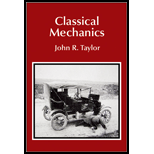
(a)
Show that in center of mass frame, the individual kinetic energies of the two particles are separately conserved in elastic collision.
(a)
Answer to Problem 14.29P
The individual kinetic energy of two particles is separately conserved in CM frame.
Explanation of Solution
Consider the elastic scattering of a particle of mass
The center of mass velocity of the system is
The velocity of particle of mass
The velocity of particle
The particles
Velocity of mass
Therefore,
Velocity of mass
Therefore,
The kinetic energies of
Before collision,
After collision,
Conclusion:
Thus, the individual kinetic energy of two particles is separately conserved in CM frame.
(b)
Reason why the result in sub-part (a) is not true in laboratory frame.
(b)
Answer to Problem 14.29P
In lab frame, particles acquire kinetic energy only after collision.
Explanation of Solution
In laboratory frame, the kinetic energies of the particles are not conserved separately because the particle initially at rest has no rest kinetic energy before collision, but acquires kinetic energy after collision.
Conclusion:
In lab frame, particles acquire kinetic energy only after collision.
(c)
Show that the fractional energy lost by the projectile in lab frame is
(c)
Answer to Problem 14.29P
The energy lost by the projectile is
Explanation of Solution
The relation between velocities in the center of mass and the laboratory frames is shown in figure 1.

From the cosine law of triangle, the velocities of the particle are related as
The fractional loss in kinetic energy of the particle in the lab frame is
Further solve,
Substitute
Hence proved.
Conclusion:
The energy lost by the projectile is
(d)
What sort of collision gives the largest energy loss?
(d)
Answer to Problem 14.29P
Masses of both the projectile particle and target particle should be approximately equal for the appreciable energy lost in nuclear reactions.
Explanation of Solution
Differentiate
The value of
Thus
Conclusion:
Masses of both the projectile particle and target particle should be approximately equal for the appreciable energy lost in nuclear reactions.
Want to see more full solutions like this?
Chapter 14 Solutions
Classical Mechanics
 College PhysicsPhysicsISBN:9781305952300Author:Raymond A. Serway, Chris VuillePublisher:Cengage Learning
College PhysicsPhysicsISBN:9781305952300Author:Raymond A. Serway, Chris VuillePublisher:Cengage Learning University Physics (14th Edition)PhysicsISBN:9780133969290Author:Hugh D. Young, Roger A. FreedmanPublisher:PEARSON
University Physics (14th Edition)PhysicsISBN:9780133969290Author:Hugh D. Young, Roger A. FreedmanPublisher:PEARSON Introduction To Quantum MechanicsPhysicsISBN:9781107189638Author:Griffiths, David J., Schroeter, Darrell F.Publisher:Cambridge University Press
Introduction To Quantum MechanicsPhysicsISBN:9781107189638Author:Griffiths, David J., Schroeter, Darrell F.Publisher:Cambridge University Press Physics for Scientists and EngineersPhysicsISBN:9781337553278Author:Raymond A. Serway, John W. JewettPublisher:Cengage Learning
Physics for Scientists and EngineersPhysicsISBN:9781337553278Author:Raymond A. Serway, John W. JewettPublisher:Cengage Learning Lecture- Tutorials for Introductory AstronomyPhysicsISBN:9780321820464Author:Edward E. Prather, Tim P. Slater, Jeff P. Adams, Gina BrissendenPublisher:Addison-Wesley
Lecture- Tutorials for Introductory AstronomyPhysicsISBN:9780321820464Author:Edward E. Prather, Tim P. Slater, Jeff P. Adams, Gina BrissendenPublisher:Addison-Wesley College Physics: A Strategic Approach (4th Editio...PhysicsISBN:9780134609034Author:Randall D. Knight (Professor Emeritus), Brian Jones, Stuart FieldPublisher:PEARSON
College Physics: A Strategic Approach (4th Editio...PhysicsISBN:9780134609034Author:Randall D. Knight (Professor Emeritus), Brian Jones, Stuart FieldPublisher:PEARSON





